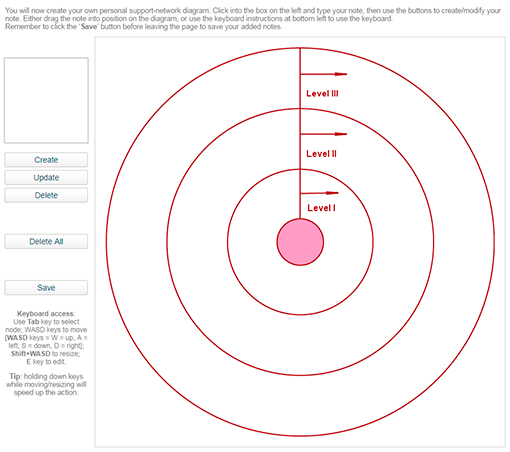2.4 Social exclusion: the impact of social support
Social support networks can be described as the pattern of relationships and levels of support available to an individual or a family. The support provided and received within networks may include emotional support or practical help. In practical terms, this most likely refers to the locality or community where they live. However, personal social-support networks may also be geographically dispersed, with contact being maintained via the internet through email and social networking sites, and by telephone. A service user’s network may include, for instance, relatives, friends, colleagues, neighbours, support groups, a local place of worship, volunteers, and health and social care provision. The composition and types of support available within support networks will change across a person’s life course.
Activity 2 Finding out about personal support networks
In this activity you will think about your own personal support network, and construct a basic social-network diagram, using a method adapted from the figure below, which provides an example of a personal support network for an older person, taken from Phillips et al. (2000, p. 842). For this activity you will focus on identifying the personal support networks you can draw on to support you as you study this course.
Click on the figure below or on ‘View interactive version’.
Using the interactive diagram, now create your own personal support network diagram.
- Begin by writing ‘YOU’ on a Post-it and put it into the small circle at the centre.
- Next, on individual Post-its, write the names (and their relationship to you) of those individuals without whose support you find it difficult to imagine successfully studying. Put these Post-its into the Level I circle.
- In the Level II circle, in the same way as for Level I, add those people that you are ‘less close to’, but who are ‘still very important’.
- Finally, in the Level III circle add any people who you have not already mentioned but who are important enough in your life to be included.
Now think about the variety of support functions (emotional and practical) that the network members you have identified on your diagram provide, or receive, and put this information into the table below.
| Name | Emotional support | Practical support |
|---|---|---|
Answer
You have looked at the structure of your social support network that you may draw on while studying this course and considered its functions in terms of the kinds of support given and received. There may be friends, work colleagues, fellow students or family members, for example, whom you could rely on to offer emotional support if required. You may also have identified people who can sometimes provide you with practical support. For example, some people may have neighbours who might help with childcare on occasions.
Constructing a network diagram with a service user can provide a useful starting point from which to explore in greater detail the nature of support, the frequency of contact, and the level and support offered by the people included in the network.
People who are important to service users may not always be family members. Importance may be related to who keeps in closest contact and most frequently, or it may not. Many families today are spread over wide geographical areas, and regular telephone and internet contact may be useful substitutes for visits.
Social network diagrams and ecomaps can be useful tools for visualising and assessing a service user’s social support.

